First up, wrenching on SRAM road shifters with Muc-Off. I've used a set of Rival hand perches for 4 seasons, and they've served me well. However well protected the internals of SRAM shifters are compared to Shimano's offerings, the fact remains that lots of contamination finds its way inside over the course of all manner of riding, not least, cyclocross. Horrible? No. Deserving of attention? Certainly.
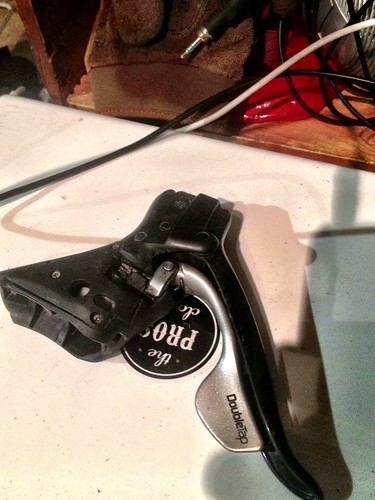
First, remove the hood from your shifter, off the bike. You need new cables and housing anyway, right? This is going to work way better if the shifter starts like this.
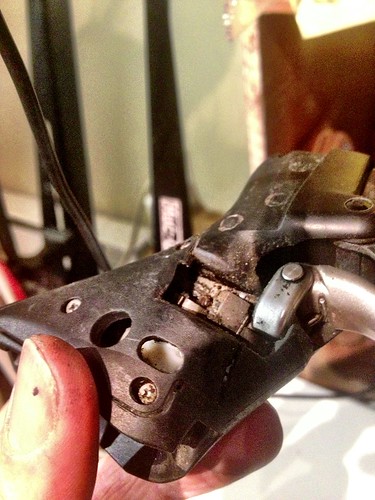
See the filth? Nasty. That stuff is not good for the function and durability of your shifters. Remove this plate under my thumb with the proper small Phillips screwdriver. Don't lose the screws.
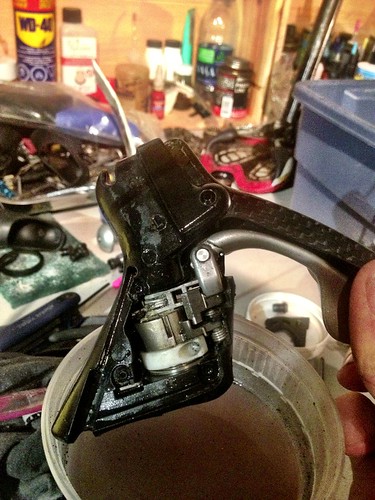
Here's where the Muc-Off comes in. I didn't want to use a harsh solvent, so I took Muc-Off's terrific pink cleaner and diluted it in hot water in an old granola container. Go ahead, I've been called a 'granola' before. Whatever. Soak the shifter.
Grab your spouse's toothbrush and scrub away at the internals, removing all the contamination you can. Rinse, lather, repeat. Know that you are cleaning away some of the grease that is/was in there from the factory. This means you might well have to add some lube periodically. Know that.
Rinse with warm water. The Muc-Off is designed to come off this way. If you are paranoid about residue, flush it with rubbing alcohol.
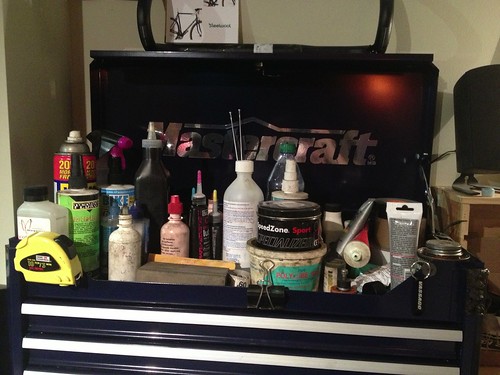
As you can see from the photo of my tool chest, I have a lot of lube options. Muc-Off's lubes are great, but I've not been using them long enough to try one in my shifters. Instead, I used Tri-Flow, which is indispensable in the shop. It is not sticky, so it won't collect contamination. It's pretty durable too. Lube it up. Word of caution, if you have Muc-Off's ceramic lube (pink top), DO NOT use it for any parts with small moving parts. It gums up and restricts part function. It can be used on cables, where it is quite slick, and of course, chains. However, it collects a lot of debris, which then hinders performance. Its an odd one.
Ok, now you need to dry out the shifter. I use a compressor and blow-nozzle to blast air in, moisture and dirt out. If you don't have a compressor, air dry the part, then lube up all the moving bits and re-install the covering plate. You are now ready to re-install the hood and mount the shifter back onto your bike. If you are worried about getting the positioning right, tape the bar where the top of the shifter sits before you remove it, then line it up again.
Now you are ready for cabling. Remember, new cables and housing alone can make a tired bike feel fresh. Replace them at least once a season on a bike you ride regularly to maintain solid performance. Note that excess friction in the cables and housing loads makes your shifters work harder, and wear out faster. I will do a post specifically on cable and housing in the near future.
While your shifters would likely be going back onto your road or cyclo-cross bike, mine are now adorning my Velo-Tout-Terrain (VTT) machine. 'VTT' is what the French call 'mountain bikes,' and, with all honesty, that name is far more appropriate for our fat tire machines than 'MTB.' The truth is, the minority of mountain bikers ride mountains....ever. Hills, sure; mountains, not so much. Perhaps like the Beta versus VHS battle, the term 'All-terrain Bike' vied for supremacy back when I was a kid ripping around on a Sears POS (no, that does not denote 'point of sale'). The english-speaking fat tire crowd settled on MTB, and ATB died away. Meanwhile, in Europeland, VTT was the term that stuck.
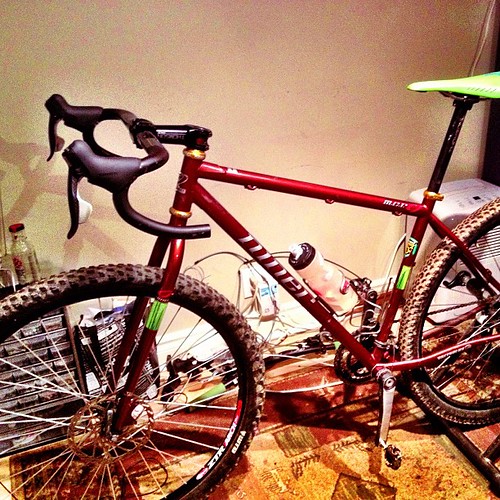
Driving home from Battenkill last April, Iain and I decided he should convert his custom steel Waltworks hardtail to a 650b drop-bar rig. Why not try it? What to call it? We settled on VTT, because 'monstercross' just didn't apply; there is nothing cyclo-cross about the format. We're talking John Tomac -ripping-it-up-up-with-a-Tioga-disc-wheel style here, minus the disc wheel. See, Tomac was a phenom. He raced BMX at a high level as a kid, then raced both PRO road with Bob Roll on 7-11, and MTB for a few teams, perhaps most well known, Giant.
Iain's bike came out great, and he put in a few hundred kilometers on in over the fall. Since we both like to do long off-road rides, and the majority of trails in Gatineau Park that are open to bikes are wide open, we are keen on seeing how we make out on this platform. Cyclo-cross bikes handle a lot of the trails in the park, but since we both like to stay off the brakes, and we don't like flats and dented rims, working with a MTB platform and running drop bars will get us into a comfortable position with multiple hand-holds, out of the wind on the road sections we ride, and generally allow us to ride wherever we want, fast. 650b and 29er wheels lend themselves to this set-up, 650b being ideal for smaller riders.
My bike is a Niner MCR, which is a Reynolds 853 steel frame. I'm using an XTR crankset with two rings, SRAM X9 10 speed rear derailleur mated to the Rival shifters, and Avid BB7 Road mechanical disc brakes. I've mounted a short and shallow drop bar on the same stem I used with a riser, and its 2cm wider than usual. This gives me the same reach and drop I use on my cyclo-cross bike.
I'll use a variety of tires, but nothing extremely aggressive. The key to fast rolling tires with minimal tread will be the Stan's Flow EX rims I'll build up, which feature 25mm wide bead hooks, setting up the tires with more volume than usual. Rims are getting wider across most disciplines, and MTB and VTT are no exceptions, especially with the mainstreaming of tubeless tires. Look out for a future post specifically on this topic.
We'll be taking these bikes to D2R2, and we'll ride them during our own Double Cross too. Underbiking has its place, but we're pumped to ride these bikes a lot in 2013! Are we alone here, or are any of you intrigued? Would you like to convert an MTB you've got to a VTT? Drop in at Tall Tree Cycles; the guys can help.
 |
| Iain and his Waltworks. |
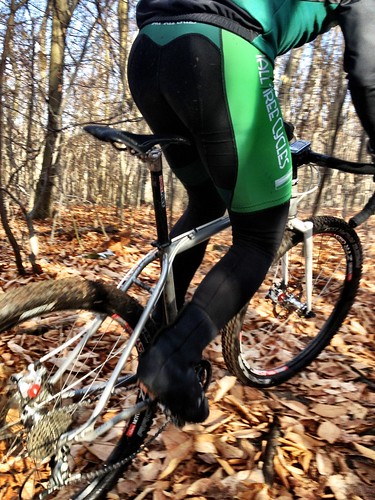


No comments:
Post a Comment